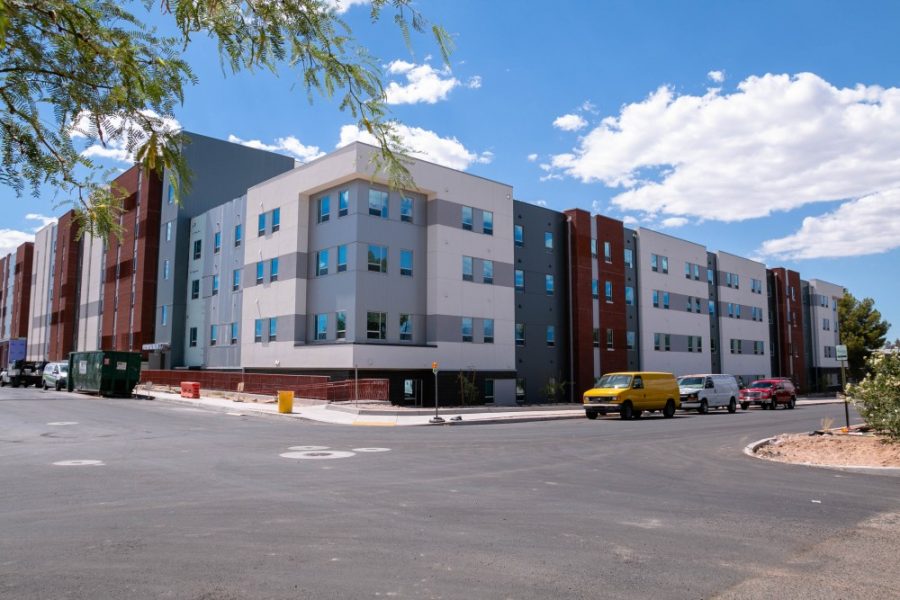The new Honors Village, set to open in fall 2019, towers over the surrounding neighborhood. The parking garage sits empty, built to serve the proposed academic and recreational spaces as well as around 1,000 residents.
The Honors Village is the new home for the University of Arizona’s Honors College, which before was spread out around campus, and comes in conjunction with other efforts to centralize programs like the new UA Global Center.
As construction nears completion for the 2019 fall semester, the potential impacts are not yet apparent. For students, it provides a new mixed-use space that allows for a combination of academic, residential and recreational uses in one centralized place that is mainly unseen elsewhere on campus.
“A lot of universities over the last decade or so invested a lot of money in [amenities] because it’s attracting students not just through the academics,” said Meagan Ehlenz, a professor in the School of Geographical Sciences and Urban Planning at ASU who researches the role of anchor institutions in urban environments. “They’re competing for students and so they’re trying to get them to come on an entire lifestyle rather than just the academics.”
This creates a new space that is more than simply academic, creating an appeal to the available lifestyle at the UA, which, in the long-term, is designed to attract increasing numbers of students and in tandem a growing number of residents.
RELATED: Primary candidates discuss student housing, gentrification
“You’re going to have hundreds of more people with hundreds of more cars,” said Steve Kozachik, council member for Ward 6 of Tucson, noting that taxpayers would pick up the costs of impacts on roads and infrastructure affected by the increased density, a concern echoed by Diana Lett, the Feldman’s Neighborhood Association president.
Impacts from the Honors Village that will ripple out into the surrounding community are still yet to be seen. To combat some of the potential effects, the UA, in the project’s initial development stages in 2017, made concessions to the surrounding neighborhood in community talks.
The UA has implemented multiple protections to try and ease the potential impacts of the project, including vegetation buffers, a lack of balconies or rooftop activities, a focused entrance from Fremont Avenue facing the campus and storm water basins for potential runoff.
Residents like Lett argue that it hasn’t been enough, though, and that grievances are still present despite the project’s close arrival.
“Most of the concessions were cosmetic,” said Lett via email.
Kozachik offered criticisms of the project’s initial stages but also stated that, “the [UA] does a better job of project management with those kinds of concerns than the city does.”
The Honors Village offers a new potential framework for student housing through its mixed-use outlook but also extended the traditional campus boundaries. The space initially had no specific planned usage in the 2009 Campus Plan.
Kozachik criticized the project for extending traditional boundaries and shifting expected growth outside of campus.
“People make investments and decisions based on what the anticipated growth patterns are,” Kozachik said. He further added that the economic benefits may be outweighed due to impacts on infrastructure and students generally not spending money in the area.
Chris Sigurdson, vice president for UA Communications, declined to comment on the construction of the Honors Village.
Regarding the potential impacts on surrounding housing that university developments can have, Ehlenz said that, “when a university starts to invest in a neighborhood and starts to develop, developers see that as a signal that we’ve got a long-term player here … They’re investing millions of dollars, so we’re going to buy into this and start to develop things too while there’s a dependable market.”
As private developers increasingly move into the area surrounding campus, prices continue to rise. While the Honors Village is the most expensive dorm presently on campus and requires a meal plan with some exemptions, it reflects potential cost changes for the community and the impact the UA can have on costs in surrounding areas.
Ehlenz mentioned Duke University as an example of a university being mindful of the community, as they have donated to organizations to protect affordable housing like community land trusts or Habitat for Humanity.
“The best thing that I’ve seen universities do is have a very open and collaborative process with their community,” Ehlenz said, “where they’re really taking into account that they are a major investor.”
Follow The Daily Wildcat on Twitter









